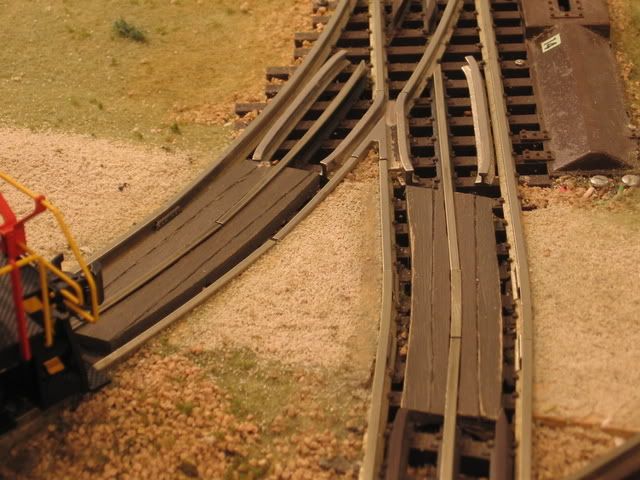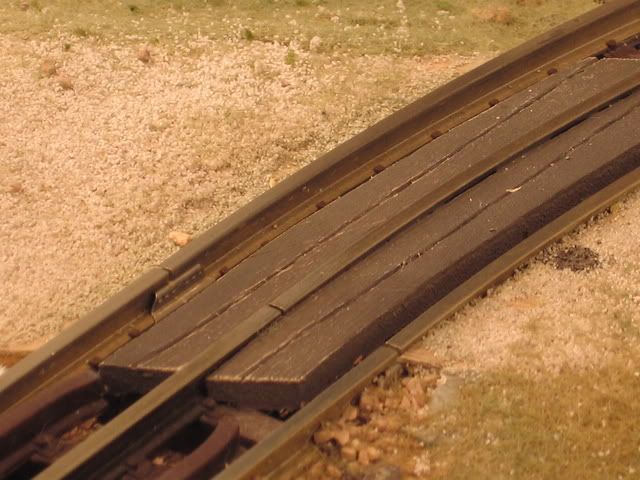Is there a recommended method to create a road crossing over classic lionel 3 rail rack? Do you insert some material in the gaps between the rails to simulate the raised up appearance of a real RR crossing? I saw a YouTube video of a guy using drywall compound on his Fastrak layout to fill in the gaps but I'm not sure I like that idea if there are alternatives.
Replies sorted oldest to newest
Dont know if this might help. Its using mth realthrax for a shelf layout but the concept is a sound one ![]()
That's beautifully done thanks. I too am modelling a country setting so your method will be perfect
Woodland Scenics N Scale Track-Bed simulates asphalt pretty well.
I think the rural crossings "in the day" were wood, creosoted. Use balsa strips painted or stained (looks more like creosote) black.
Great, glad I could help
Mike Wyatt posted:Woodland Scenics N Scale Track-Bed simulates asphalt pretty well.
I think the rural crossings "in the day" were wood, creosoted. Use balsa strips painted or stained (looks more like creosote) black.
This is the same method I use. Just hot glue it in place. Perfect fit and plenty of room for the wheel flange. And it works great on curves too.
For other areas where pavement is not desired, I put my material down and push rolling stock over the grade continuously until the wheels roll freely. Then spray on wet water and glue the material with diluted white glue.
Have Fun!
Ron

Attachments
Great tips all..yes of course planks were used back in the day and my new (first) train board depicts the Summer of 1959 so planks would be appropriate. I have some very narrow coffee stirs that would look great painted black and inserted between the rails.
Attachments
Good morning, you can use foam board cut in strips to fit between the rails. As mentioned above just keep the foam board toward the center rail so the wheel flanges clear the foam board.
A sheet of foam board can be purchased at any craft store.
It's cheap and comes in different colors and easy to work with it. You can paint the foam board with any craft paint.
The attached photo although not the best angle shows the roadway between the two tracks which is foam board also.
The white edges are made from Woodland Scenics Flex Paste built up to look like a snow windrow that a snow plow would leave behind.
At least in my winter wonderland !
Merry Christmas !
Attachments



Luan board cut to fit, adjusted with a bench sander. Scribe tool and a straight edge for the board marking. Glued in place.
I might add that putting a slight taper on the flange side of the ends of the planks between the rails ensures that an out-of-gauge wheelset doesn't ride up on the planks causing all kinds of havoc. The taper will direct an errant flange into the flangeway. It doesn't take much of a taper, and it is not noticeable unless you are looking for it. This is the same principle that is used on guard rails for switches.
Tom
Make sure that any Marx locomotives or prewar locos with "fat" wheels will go through the gaps between the boards and the rails.
In the 1940s to 1950s era that I model, railroad crossings often had boards within the track gauge. First photo shows the multiple grade crossing on my 2004 12X8 layout. The boards within the rails are strips of stained basswood. The pavement extending up to the outsides of the rails is wall spackle over basswood sheets painted with several shades of gray and brown acrylic.
Second and third photos are from the O-54 curved grade crossing on my current 10X5 layout. The crossing boards were produced by Blair Line LLC (blairline.com) and fit perfectly into the gauge. You can also see how I trimmed the ends of the boards adjacent to the outside rails to guide train wheels into the gap. I had derailments before trimming. The clearance in the gaps is between 1/8-inch and 5/32-inch. No clearance necessary at center rail but boards must be slightly below top of rail. Boards secured to track ties with epoxy.
MELGAR
Attachments
I just checked out the "blairline.com" website mentioned by Melgar and I must say was really impressed by the appearance so I think I will go with their product.
I used craft sticks (popsicle) and cut the rounded ends off and painted them. I used Apple Barrel brand 21490E Pavement acrylic paint from WalMart. Looks good to me. I use Atlas track.
That's another great idea. Do you use hot glue or some other adhesive so they don't ride up and de-rail the train?
I used a couple dabs of hot glue.
OK, thanks, that's what I thought you used.

















